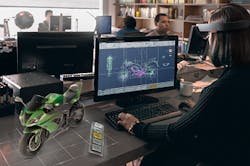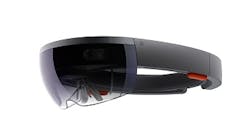Can Microsoft HoloLens augmented reality technology help improve water infrastructure?
LONDON, England – Imagine a future where water plant operators can augment reality with holograms to help them fix technology, such as pumps or valves.
The process would be logged seamlessly and wirelessly in real time to the utility’s central control system.
Well current developments with Microsoft’s HoloLens technology, which blends 3D digital content into the physical world, could see this futuristic vision turned into reality.
Compared to previous virtual reality technology, which replaces the real world, HoloLens lays holograms with the real world and augments this with information.
Below is a demonstration video of the technology:
At its Year In Infrastructure (YII) 2016 Event held in London, software company Bentley Systems demonstrated how the technology can be used in a plant maintenance context.
Visitors could “experience the future of plant maintenance”, according to the company, such as doing “complex maintenance tasks helped with a virtual assistant that guides you along the way”.
Speaking to WWi magazine on the sidelines of YII, Robert Mankowski, VP of software development for Bentley Systems, said: “Virtual reality has been around as a concept for ages but never really took off. But now I think it’s going to take off.”
Discussing mixed reality and the use of HoloLens technology, he said: “The idea is that you may be in front of a piece of plant equipment wearing the HoloLens. Then you actually see the procedure manual floating in the air and perhaps even have a virtual avatar talking to you, telling you how to execute this procedure. For example, a valve could have an augmented arrow over it, saying which part to turn clockwise or anti-clockwise.”
The HoloLens system responds to three types of commands: Gaze, Gesture and Voice. The development edition of the HoloLens was available for shipping from March, at a price of $3000.
Two years ago WWi magazine reported how virtual reality technology such as the Oculus Rift is being integrated into project design.
In one scenario it enabled a consultancy to pick up on a design clash, move a pump and eventually save £2 million in project design costs (read story).
Aidan Mercer, industry marketing director, utilities and government for Bentley Systems, believes it is in the virtual environment where dangerous scenarios can be replicated for training purposes.
He said: “I think there’s a place for training in this type of virtual environment. For example, putting people in scenarios that are abnormal and being able to simulate a very dangerous situation in a water network. If you can have the reality models you can place a figurine to walk down and you can simulate a dangerous situation without endangering yourself.”
Reality modelling was also an important topic mentioned throughout YII 2016. Host company Bentley Systems announced a partnership with surveying and construction company Topcon Positioning Group.
###
Read more
Virtual reality Oculus headset helps self-sufficient WWTP save £2m in design costs





